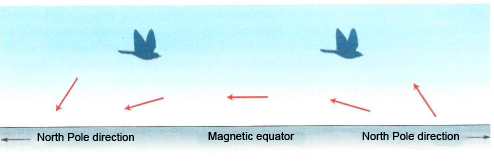
To choose and maintain a direction of movement you need a compass. But what’s the point of a compass if I don’t know my position with respect to the destination I want to reach?
When a racing pigeon intends to embark on its flight home, it must first understand where home is. This is the great problem of navigation mechanisms in the animal world, common to all processes of orientation towards a distant destination, both migration and homing (returning to a nest, a territory, or a common place of rest, after an experimental dislocation or produced by environmental or behavioral events).
As the German researcher Gustav Kramer taught us in the 1950s, every process of orientation from unknown places is based on a mechanism composed of two phases which he called “map and compass”.
The map phase is the one that allows you to identify your position with respect to your destination and therefore to establish the direction to take as a result, guided by a compass.
In order to get compass information, animals have demonstrated the ability to rely on different reference systems such as the sun, moon, stars, and the Earth’s magnetic field.
On how the map phase can be carried out, our information is completely insufficient, although the most varied sources of reference have been used: theories, and suppositions, but a convincing experimental demonstration of the reference system(s) possibly involved is still missing. Once upon a time sailors took stock with the sextant and today we can all use a modern GPS, but animals have neither one nor the other.
The compass that we humans use is made up of a magnetized needle free to rotate on a pin, so as to position itself parallel to the lines of force of the magnetic field which, starting from the south pole, envelops our planet up to the north one. The needle consequently indicates the direction of the magnetic north pole, similar to but not coinciding with the geographic north pole. Ancient navigators and peoples who migrated long distances used the Polar Star to orient themselves; the Polar Star is located near the north celestial pole and indicates the apparent rotation axis of the starry sky.
Due to the precession of the equinoxes, the pole moves across the celestial vault, and consequently, Polaris is not always the same; to date, α Ursae Minoris, the first star of the helm of Ursa Minor, is Polaris which is no more than one degree distant from the celestial pole. The star closest to the south pole is the σ (sigma) of the constellation Octans, home of the south celestial pole. It is also known that the sun at noon culminates in a southerly direction and that it rises in the east and sets in the west, in its apparent motion. Therefore we know how to exploit three reference systems to derive the position of the cardinal points and orient the directions of motion.
In the animal world, the possibility of exploiting the different physical or celestial stimulating sources is more varied and depends greatly on the behavior of the different species, whether sedentary or migratory. The sun seems to be the most widespread reference system among both vertebrates and invertebrates, according to experimental evidence. However, there is a fundamental difference in the use of reference systems: the magnetic perception mechanism is innate, while the stellar and solar ones must be learned in youthful and perinatal periods. This appears to have been demonstrated experimentally at least for birds. Thus a passenger pigeon knows how to orient itself with the sun from the age of two months and a robin exploits the stars after a comparable period of observation of their apparent nocturnal rotation motion.
But how did we come to understand how animal compasses work; what is the history of the research that led us to understand them? Let’s start with the stellar one, postponing the others to future appointments.
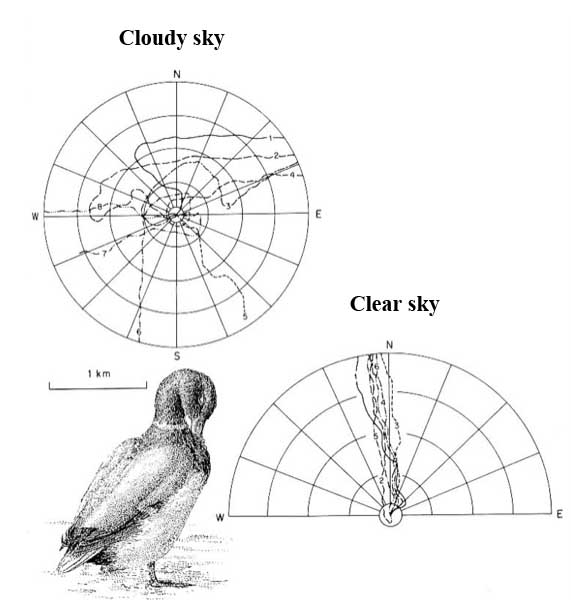
(From Bellrose 1958)
It all started at the Bremen Naval School, where in addition to Kramer the spouses Franz and Eleonore Sauer also worked. Although it had long been understood that the orientation of nocturnal migrants was more uncertain during overcast nights (Fig. 1), from the Sauer experiments it was immediately clear that complete coverage induced a clear disorientation in the nocturnal migrants they tested. Blackcaps, warblers, and graylings chose the right autumn or spring migration route under the starry sky; when the stars were not visible “they moved aimlessly, without a precise direction”.
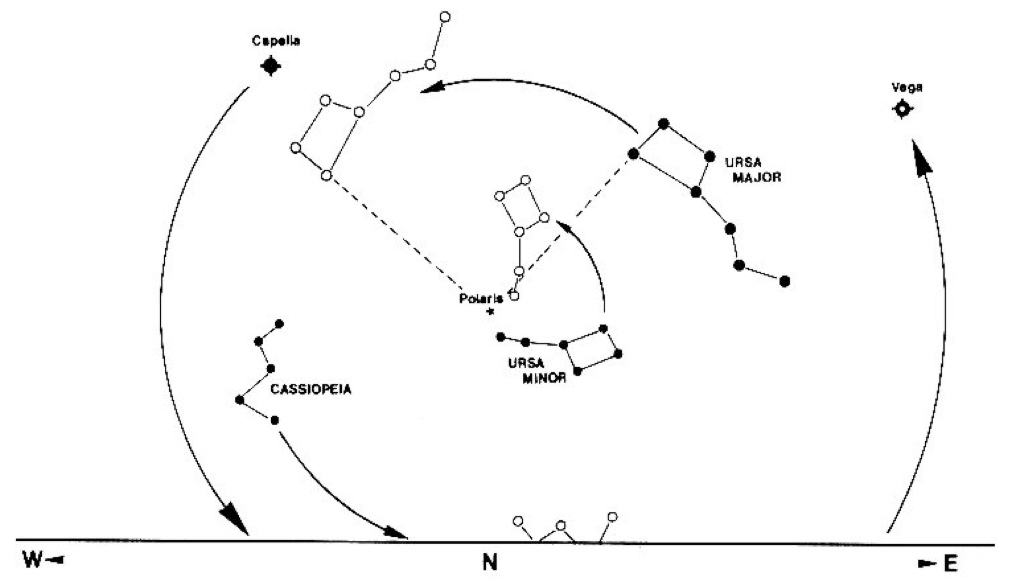

About ten years after these truly generic indications, it was the American Stephen Emlen who clarified how things actually were. The crucial point was the three series of experiments that he conducted under the sky of a planetarium with specimens of the passerine Passerina cianea raised by hand in visual isolation from any celestial reference. Exposed in the first weeks of life (before migration) to a “natural” sky, rotating around Polaris, the passerines were able to choose the normal seasonal migration route towards the south. However, it was necessary for them to be able to see at least the segment of the sky with a radius of 35° around Polaris, where the stars have a lower linear rotation speed, to correctly identify the axis of rotation of the constellations (Fig. 2 and 3).
In the second series of experiments, he verified that the phase shift of their endogenous clock, implemented by anticipating or delaying the day/night rhythms compared to the natural ones, had no effect on the directional choice, which was therefore independent of the sense of time (Fig. 4) .
If the celestial vault of the planetarium remained fixed, the sparrows would not learn to orient themselves despite the vision of a natural starry sky.
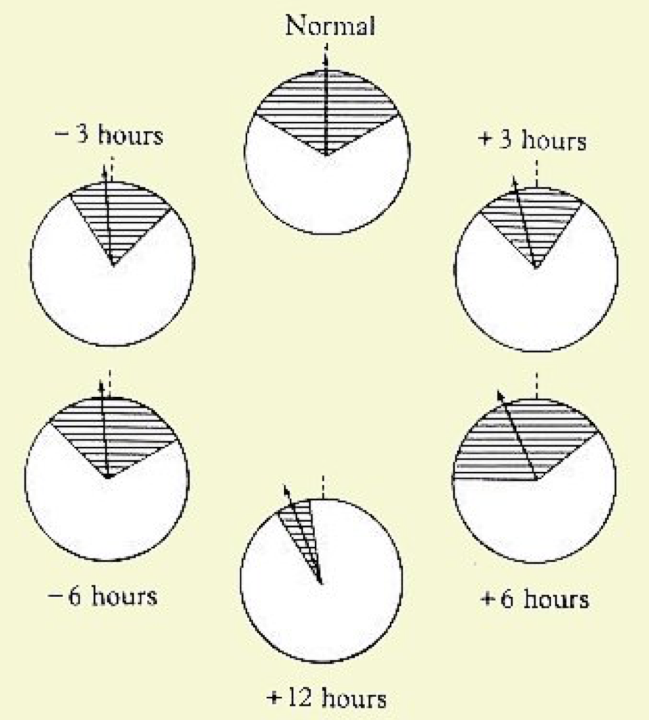
A group of passerines was finally exposed during the juvenile period to a natural sky that did not rotate around Polaris but around Betelgeuse, a star in the constellation of Orion (Fig. 5). Tested in autumn, these birds chose a flight direction that was “correct” for them in relation to the sky they could see, but incorrect compared to the direction of migration of the species.
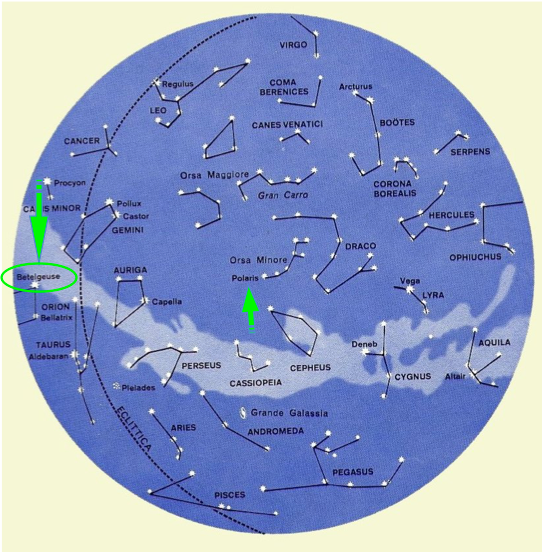
On the basis of this evidence, it was easy for Emlen to conclude that the stellar compass was learned by birds in a narrow postnatal period of life, based on the observation of the rotation pattern of the night sky around a fixed point represented by Polaris.
The star compass, therefore, is not “chronometric” as it is independent of the sense of time. There are no genetic factors that determine it but it must be learned. Emlen published his results in the prestigious journal Science in 1970 with a paper entitled “Celestial rotation: its importance in the development of migratory orientation”. The ontogenesis and functioning of the star compass was no longer a mystery!
Credits
Author: N. Emilio Baldaccini. Former Professor of Ethology and Conservation of Zoocenotic resources at University of Pisa. Author of over 300 scientific papers on national and international journals. He is active in the field of scientific education, and co-author of academic textbooks of Ethology, General and Systematic Zoology, Comparative Anatomy.
Translation by Maria Antonietta Sessa



